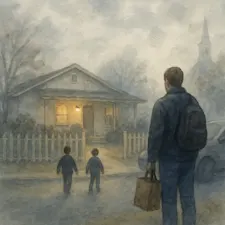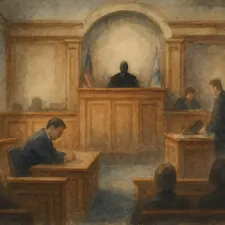
Unsolved Nightmare: Texarkana's 'Moonlight Murders'
In 1946, the quiet town of Texarkana became the setting for one of the most infamous murder mysteries in American history. A series of brutal attacks and murders shook the area, leaving its residents paralyzed with fear. Despite decades of investigation, the Texarkana "Moonlight Murders" remain unsolved, with the identity of the killer still a mystery. This case, marked by its gruesome nature and unanswered questions, continues to haunt the region, fueling rumors and speculation.
The 'Moonlight Murders' Begin
The violence began on Feb. 22, 1946, when Jimmy Hollis and Mary Jeanne Larey were attacked on a secluded road by an armed man wearing a burlap sack over his head, with two slits for him to see through. Hollis was brutally beaten, sustaining a fractured skull, while Larey was sexually assaulted. The attacker fled after seeing an approaching vehicle, and though both victims survived, it marked the start of a terrifying killing spree.
 Officers working the "Phantom Killer" case in 1946, gathered in the Miller County Sheriff's office. Photo by Tillman B. Johnson, Sr. courtesy of the Texarkana Gazette. Public domain.
Officers working the "Phantom Killer" case in 1946, gathered in the Miller County Sheriff's office. Photo by Tillman B. Johnson, Sr. courtesy of the Texarkana Gazette. Public domain.
In March, Richard Griffin and Polly Ann Moore were found shot in the head with a .32 caliber gun on another remote road. Blood splatter evidence suggested the couple had been killed outside the car and then placed back inside.
In April, the bodies of Paul Martin and Betty Jo Booker were found in Spring Lake Park, also killed with a .32 caliber gun.
Both female victims had been tortured and sexually assaulted, escalating the fear within the community.
In May, the killer struck again, this time targeting a couple in their farmhouse. Virgil Starks was shot through a window and killed instantly. His wife, Katy, was shot twice but managed to escape despite her injuries. While the weapon used was different, a .22 pistol, similarities in the tire tracks linked this murder to the same perpetrator. In total, five victims were killed during this spree, spreading panic across Texarkana as residents armed themselves and law enforcement from both sides of the city worked together to stop the culprit.
Each of the murders took place late at night, often on weekends, in or near secluded areas. Despite efforts to lock down the area and prevent further attacks, the killer continued to elude capture. The community, gripped by fear, enforced a curfew, with businesses closing early and residents staying indoors after dark.
The media quickly coined the term "Moonlight Murders" for the series of killings, though the last attack took place near a new moon. Due to his ability to attack and disappear without a trace, the local newspaper, the Texarkana Gazette, referred to the assailant as the "Phantom Killer."
Investigations and Theories
The investigation into the "Moonlight Murders" was fraught with challenges. A lack of forensic technology at the time made it difficult for law enforcement to gather concrete evidence, leaving the case primarily reliant on eyewitness testimonies and circumstantial clues. Several suspects were questioned, but none were definitively linked to the crimes. One of the most prominent suspects was Youell Swinney, a habitual criminal arrested for car theft shortly after the murders.
Arkansas law enforcement officer Max Tackett observed a pattern of stolen cars being reported just before each murder. Although Swinney's wife initially implicated him in the murders, she later retracted her statements, and no physical evidence connected him to the crimes. Due to her unreliable testimony and legal protections preventing her from testifying against her husband, no charges were brought against him. Swinney was sentenced to life in prison for car theft in 1947 but was released on appeal in 1973.
Over the years, numerous theories have emerged regarding the identity of the "Phantom Killer." Could the killer have been a local resident who blended in seamlessly with the community, or a transient passing through the area? The lack of any conclusive evidence has allowed the mystery to persist, with new theories surfacing as the decades pass.
The Legacy of Fear
The Texarkana "Moonlight Murders" left an indelible mark on the town and its people. The case inspired the 1976 movie "The Town That Dreaded Sundown," a fictionalized account that added to the chilling lore of the murders. Even today, the case attracts true crime enthusiasts and investigators, all hoping to uncover new clues and possibly solve one of America's most haunting murder mysteries.
Despite advancements in forensic technology, the case remains unsolved, and the identity of the "Phantom Killer" is still unknown. For the people of Texarkana, the shadow of those terrifying months in 1946 lingers, a grim reminder that some mysteries may never be fully solved.
References: Texarkana Murder Mystery | Texarkana Moonlight Murders























